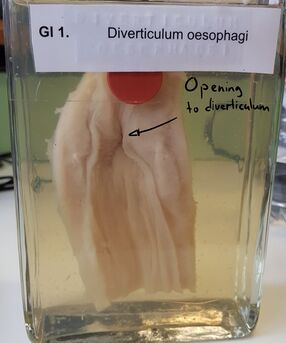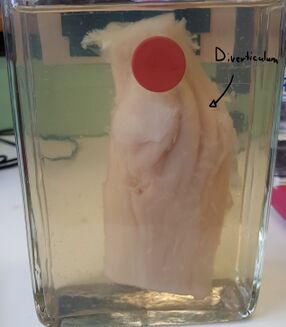1. Esophageal diverticulum: Difference between revisions
(Created page with "'''Organ''': Part of oesophagus '''Description''': On the front of the preparation can we see an opening. On the back can we see the outpouching itself. '''Diagnosis''': Zenker diverticulosis '''Cause''': * Underlying motility disorder '''Theory''': Zenker diverticulosis is one of the three types of oesophageal diverticulosis. It’s characterized by its anatomical location above the upper oesophageal sphincter. It’s also the most common type, and the outpouchin...") |
No edit summary |
||
| (2 intermediate revisions by the same user not shown) | |||
| Line 1: | Line 1: | ||
'''Organ''': Part of oesophagus | [[File:Oesophageal diverticulum front.jpg|thumb|Oesophageal diverticulum front|343x343px]]'''Organ''': Part of oesophagus | ||
'''Description''': | '''Description''': | ||
| Line 13: | Line 13: | ||
'''Theory''': | '''Theory''': | ||
Zenker diverticulosis is one of the three types of oesophageal diverticulosis. It’s characterized by its anatomical location above the upper oesophageal sphincter. It’s also the most common type, and the outpouching always faces the posterior side. Zenker diverticulosis is a pseudodiverticulosis. | Zenker diverticulosis is one of the three types of oesophageal diverticulosis. It’s characterized by its anatomical location above the upper oesophageal sphincter. It’s also the most common type, and the outpouching always faces the posterior side. Zenker diverticulosis is a pseudodiverticulosis.[[File:Oesophageal diverticulum back.jpg|thumb|Oesophageal diverticulum back. You can see how it pouches out|327x327px]]The diverticulum can compress the oesophagus. The most common symptom is dysphagia and food being trapped inside the diverticulum, from which it can be regurgitated or produce bad smell. Trapped food may also lead to perforation of the diverticulum, which can cause infection to spread to the mediastinum, yielding potentially deadly mediastinitis. However, it is often asymptomatic. | ||
The diverticulum can compress the | |||
''Because only a part of the oesophagus is present is it actually impossible to determine the exact anatomical location of the diverticulum just by looking at the prep. However, we know that this is a Zenker from before the prep was made.'' | ''Because only a part of the oesophagus is present is it actually impossible to determine the exact anatomical location of the diverticulum just by looking at the prep. However, we know that this is a Zenker from before the prep was made.'' | ||
[[Category:Pathology 2 - Macropreparations]] | [[Category:Pathology 2 - Macropreparations]] | ||
Latest revision as of 12:39, 7 July 2024

Organ: Part of oesophagus
Description:
On the front of the preparation can we see an opening. On the back can we see the outpouching itself.
Diagnosis: Zenker diverticulosis
Cause:
- Underlying motility disorder
Theory:
Zenker diverticulosis is one of the three types of oesophageal diverticulosis. It’s characterized by its anatomical location above the upper oesophageal sphincter. It’s also the most common type, and the outpouching always faces the posterior side. Zenker diverticulosis is a pseudodiverticulosis.

The diverticulum can compress the oesophagus. The most common symptom is dysphagia and food being trapped inside the diverticulum, from which it can be regurgitated or produce bad smell. Trapped food may also lead to perforation of the diverticulum, which can cause infection to spread to the mediastinum, yielding potentially deadly mediastinitis. However, it is often asymptomatic.
Because only a part of the oesophagus is present is it actually impossible to determine the exact anatomical location of the diverticulum just by looking at the prep. However, we know that this is a Zenker from before the prep was made.
